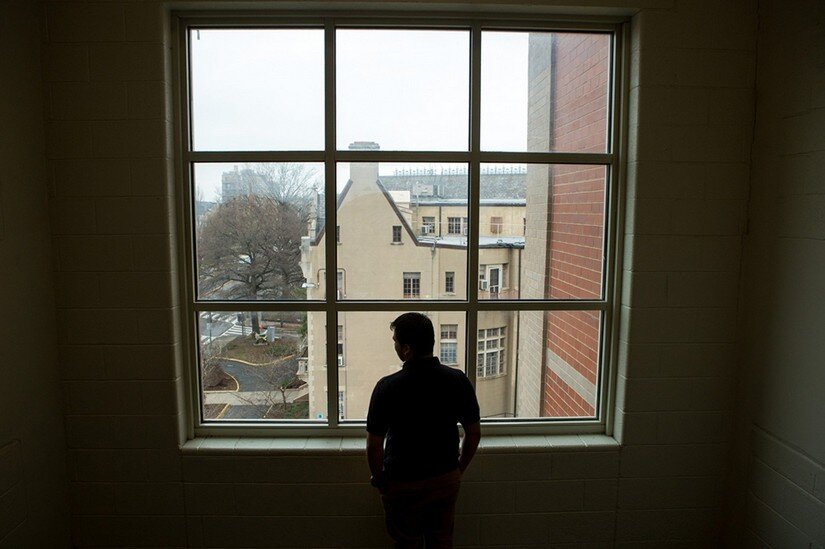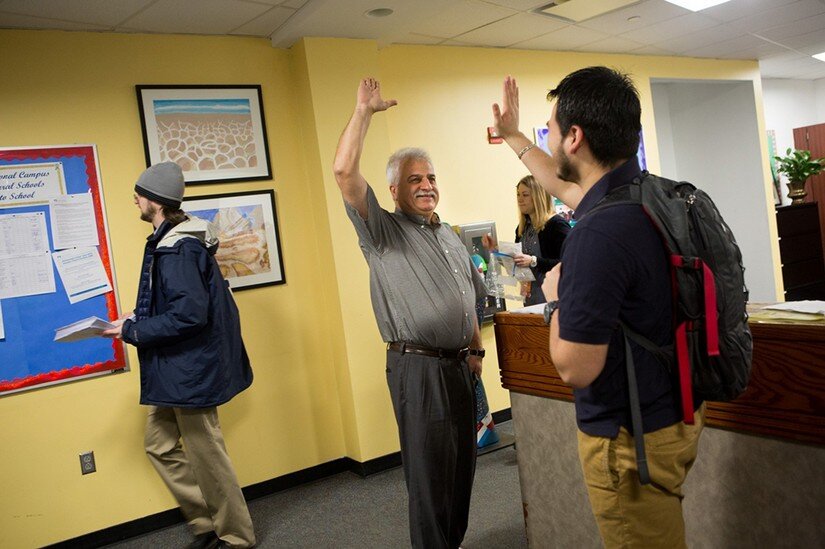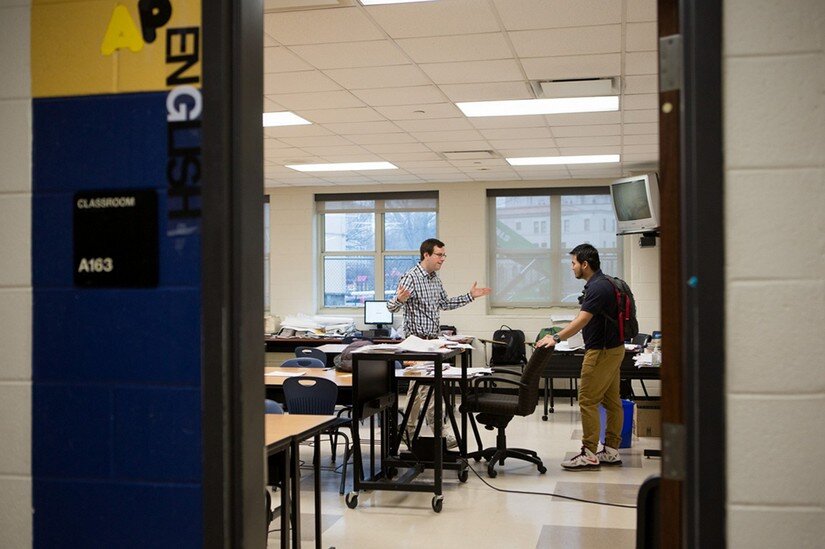
This undocumented, standout student faces another challenge: Paying for college
By Emma Brown April 11, 2016 at 1:22 PM

Edwin Ordoñez poses for a portrait at Bell Multicultural High School in Washington. Ordoñez,
an undocumented 18-year-old high school senior from El Salvador, is a superstar student.
(Allison Shelley/For The Washington Post)
Edwin Ordoñez was 9 years old when he and his father swam across the Rio Grande and slipped into this country, the final leg of a long and risky journey from their native El Salvador.


Edwin spoke no English, but he was smart, determined and focused on his education. Nine years after arriving in the United States, he is a standout student poised to graduate as valedictorian of the District’s Bell Multicultural High School.
But his impending graduation — and his quest for higher education and a better life — opened another grueling journey in the past six months. Wanting badly to go to college, he applied to 25 schools, including six in the Ivy League, but those applications came with a serious caveat: He didn’t know whether he’d be able to go, even if accepted. Like many families, his can’t afford much tuition, but unlike most other students, he’s not eligible for federal loans or grants because of his immigration status.
It’s an uncertainty that many undocumented students confront during their senior year in high school as they are crossing over from one world to the next. They are moving from a childhood when they had a right to attend public school, where teachers promised that they could achieve anything with enough hard work, to an adulthood where their legal status stands directly in the way of opportunities, including not just federal student loans but also driver’s licenses, certain academic fellowships and jobs.
“It’s a real whiplash experience. They grow up with all these kinds of messages — if you work hard enough, if you dream boldly enough, if you play by the rules, you can be something,” said Roberto Gonzales, an assistant professor of education at Harvard who has studied immigrant youth. “Now they’re moving into the really stigmatized category of an undocumented immigrant.”
About 65,000 undocumented students graduate from high school every year, according to one Urban Institute estimate that is now more than a decade old. No one knows the exact figure because schools are not allowed to collect information on students’ immigration status.

Ordoñez walks the two blocks from his apartment to Bell Multicultural High School on March 15.
(Allison Shelley/For The Washington Post)
These young people and their families have become central figures in the nation’s political dialogue amid a presidential race that has often focused on immigration policy and featured anti-immigrant rhetoric. Many people believe that the nation’s 11 million undocumented immigrants are siphoning jobs and resources away from deserving citizens and point out that these immigrants have broken the law and are here illegally.
Edwin and his teachers see him differently: as a young person who did not choose to come to the United States, but who has done his best here, and who has excelled by almost any measure.
“I’ve made this place my home,” Edwin said. “If I get sent back, I have nowhere to go.”

He refuses to hide his status.
“I feel like I shouldn’t be afraid,” he said. “I feel like it makes me who I am.”
He has many advocates among his teachers and counselors at school, none more fierce than Joseph Talarico, his English teacher, who calls Edwin a “warrior” and the most talented student he has taught in his five years at Bell.
“Edwin reaffirms my belief in the power of education to transform lives,” Talarico wrote in a college recommendation letter. “I have never seen a student work harder, and I have never seen a student soar higher.”
Edwin has taken 12 Advanced Placement classes, including calculus and computer science. He has also taken more than a half-dozen college courses. He tutors other immigrant students after school.
His SAT scores are just slightly lower than the average at the nation’s most selective schools. But Talarico said that’s more an artifact of Edwin’s family income — his mother works at a hair salon, his father at a restaurant, and they didn’t have money for a private test-prep course — than his abilities.

Advanced Placement English teacher Joe Talarico meets with Ordoñez.
(Allison Shelley/For The Washington Post)
“His writing is like jazz, full of rhythm, purposeful repetition, and elements of surprise,” Talarico wrote in his college recommendation letter for Edwin.
It was Talarico who urged him to aim high — for the big, all-but-impossible-to-get-into schools like the Ivies and Stanford, where admission rates are in the single digits. They are schools with the wherewithal to offer substantial support, financial and otherwise, for students who are lucky enough to get in.
Less-wealthy schools may be easier to get into but are just as out of reach if they can’t provide scholarship aid.
Talarico said he has had extremely bright undocumented students who have been admitted to selective colleges but were unable to enroll because tuition was unaffordable. This year, one such student has been admitted to Marymount and George Mason universities and has been granted thousands of dollars in scholarships from each school.
But that funding still is not nearly enough to cover the student’s tuition and living expenses, and she said that if she doesn’t secure additional scholarship money, she will probably attend a community college instead, with the hope of transferring to a four-year school later.
The options for many undocumented students are limited if they don’t get into a school with a large endowment — often among the nation’s most-selective schools, Talarico said.
During the past six months, Talarico has spent hours at lunch and after school helping Edwin and other students navigate the college-application process. It can be daunting for any first-generation college student, and especially opaque for undocumented youth, whose status can mean filling out extra forms and taking extra tests.
Edwin’s father, who spoke on the condition of anonymity to avoid getting in trouble with immigration authorities, said he is grateful for Talarico’s help — and proud of his son. “It’s a lot of things I want for him,” Edwin’s father said. “Like every parent, we don’t have limits for our family.”
Edwin was living with his grandparents in a small village in El Salvador, working on a farm and going to school a few hours a day, when his father told him they were leaving. They traveled to Guatemala and into Mexico, and then walked all night across the desert through a driving rain.
Once in the United States, they made their way to the Washington area, where much of Edwin’s extended family was living — legally. His mother also was here — where she had given birth to Edwin’s brother, making him a U.S. citizen — but she had no papers.
When he enrolled in the District’s H.D. Cooke Elementary in 2007, Edwin faced long odds. He was determined to beat them.
“I am a fighter,” he wrote in his personal essay for college applications. “I am an American.”
Undocumented immigrants are far less likely than other students to graduate from high school or get a college degree. Those who arrive in this country before age 14 have better chances, but they still fall short of average: 72 percent finish high school, according to a 2009 study by the Pew Hispanic Center, and of those, 61 percent go on to college.
As he learned English, Edwin set out to learn 50 vocabulary words a day. He asked his teachers lots of questions. He dived into “James and the Giant Peach” and other Roald Dahl classics.
Two years after arriving in the United States, he was scoring “advanced” on the District’s standardized math and reading tests. By middle school, some of his teachers were telling him and his parents that he could go to any college he wanted if he kept striving.
Other teachers were more blunt, Edwin said. They told him that he might get into a good school but that he would have trouble finding money to pay tuition. “Just hearing my hard work might not pay off in the end . . . I felt it wasn’t fair,” he said.
His classmate and friend Alma Garcia, who also is undocumented, said she was forced to confront that reality this school year, when she saw the stark disparity between tuition at the colleges she was considering and her ability to pay — especially given how few scholarships are open to undocumented students.
“It’s a big shock wave over you,” she said. “It’s like you’re drowning.”
Gonzales, the Harvard professor, said that moment of realization knocks many undocumented students off the path they envision for themselves. “It really derails their future plans,” he said.
Gonzales tracked 150 undocumented youth in Los Angeles for a dozen years in an unprecedented longitudinal study. Of the 79 who went to college, he said, nearly half left before receiving a degree. Even those who received degrees ended up in low-skilled, low-wage jobs — in restaurants, factories and call centers — because their immigration status hindered them in getting professional work.
The Obama administration’s Deferred Action for Childhood Arrivals policy has opened up more opportunities for college graduates. DACA — for which Edwin qualified — offers a work permit and exemption from deportation for immigrants who arrived as children in 2007 or before.
Edwin is proceeding on faith that DACA will continue under the next president, that the skills he hopes to learn in college will lead to a professional job. Enamored of computers ever since he first laid eyes on one when he came to this country, he plans to study computer engineering.
A few days ago, Edwin learned that he might beat the odds, that his dream might be within reach.
He stomached plenty of rejections. But he was accepted at eight schools, including Emory and Williams, which notified him of his acceptance in March — and Georgetown and Princeton, which accepted him when most colleges announce admissions decisions on April 1.
Georgetown said it could not offer any scholarship money to defray the estimated $69,770 annual cost of attendance — an impossible sum for Edwin.
But he won a full scholarship to Emory, and Williams has offered such a generous scholarship that Edwin would have to pay only $1,000 a year.
He is leaning toward Princeton. He loves the sense of possibility it offers. And — although he is waiting for confirmation — he thinks he will be able to afford to go.
Princeton awards full scholarships for room, board and tuition for students like Edwin, whose families earn less than $65,000 a year. If he chooses Princeton, he will pay only $1,130 next year, out of an estimated $63,690 total cost.
A door of opportunity that opens for few students — and very few undocumented students — has opened for him. “I feel good,” he said.
Talarico, his teacher, responded a bit more ebulliently, shrieking and running across his classroom when Edwin gave him the news. “It was fun,” Edwin said. “I was very happy to see him that happy.”

Edwin Ordoñez gets a high five from his AP calculus instructor Mousa Salah after telling him that he was accepted to Emory University. (Allison Shelley/For The Washington Post)
